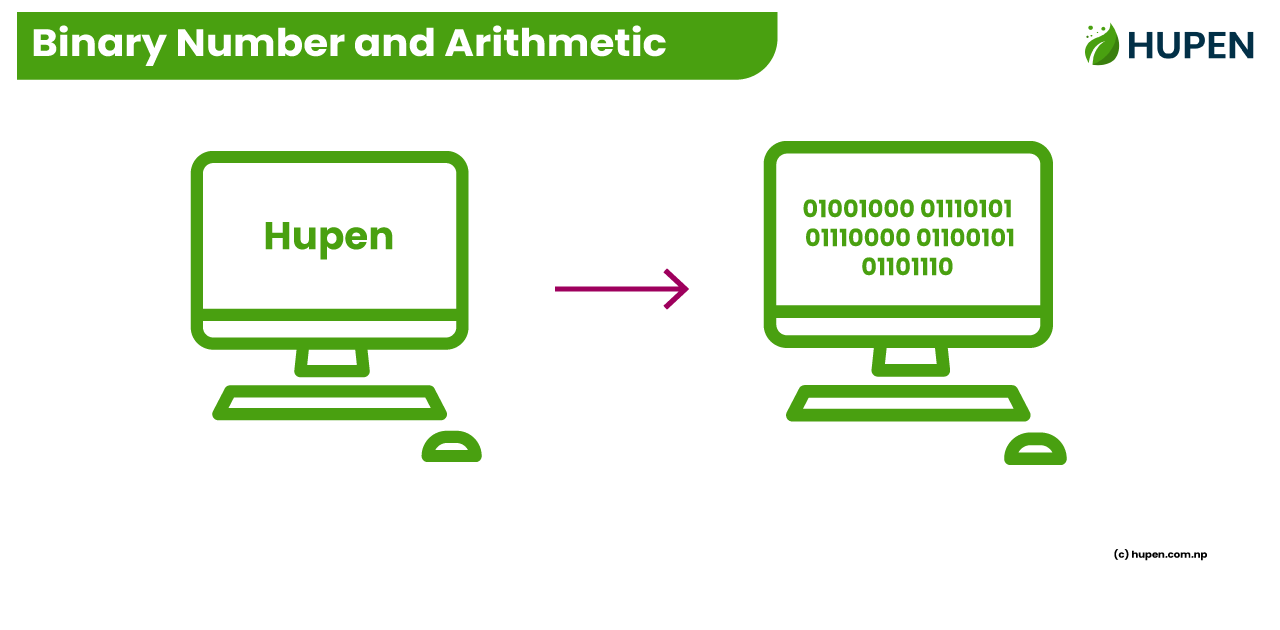What is Binary Number?
Binary numbers are the foundation of all digital systems, including computers and other digital devices. Unlike the decimal system, which is based on ten digits (0-9), the binary system uses only two digits: 0 and 1. This simplicity makes it ideal for computers, as they operate using two states, often represented as "on" and "off," or 1 and 0.
Binary numbers are written using the base-2 numeral system. Each digit in a binary number is known as a bit. By combining bits, we can represent any number or perform any calculation, just like we do with decimal numbers. Let’s dive into how binary arithmetic works!
1. Binary Addition
Introduction: Binary addition is similar to decimal addition but with only two digits, 0 and 1.
- Rules of Binary Addition:
- 0 + 0 = 0
- 0 + 1 = 1
- 1 + 0 = 1
- 1 + 1 = 10 (this means you carry 1 to the next higher bit)
Example: Add the binary numbers 1011 and 1101.
Steps:
- Start from the rightmost bit.
- Add the bits together, applying the rules and carrying over if necessary.
- Solution: \( 1011 + 1101 = 11000 \)
2. Binary Subtraction
Introduction: Binary subtraction follows a similar principle to decimal subtraction but incorporates the concept of *borrowing*.
- Rules of Binary Subtraction:
- 0 - 0 = 0
- 1 - 0 = 1
- 1 - 1 = 0
- 0 - 1 = 1 (borrow 1 from the next higher bit)
Example: Subtract 1010 from 1101.
Steps:
- Start from the rightmost bit and apply the rules, borrowing where necessary.
- Solution: \( 1101 - 1010 = 0011 \)
3. Binary Multiplication
Introduction: Binary multiplication is similar to decimal multiplication. The result can be found by multiplying and adding partial products.
- Rules of Binary Multiplication:
- 0 × 0 = 0
- 0 × 1 = 0
- 1 × 0 = 0
- 1 × 1 = 1
Example: Multiply 101 by 11.
Steps:
- Multiply each bit of the first number by each bit of the second number, similar to long multiplication in the decimal system.
- Sum the partial products.
- Solution: \( 101 \times 11 = 1111 \)
4. Binary Division
- Introduction: Binary division resembles decimal division and involves repeated subtraction and shifts.
- Rules of Binary Division:
- The division process involves subtracting the divisor from the dividend and shifting bits.
Example: Divide 1010 by 10.
Steps:
- Compare the divisor with the most significant bits of the dividend.
- Perform binary subtraction if possible, then shift.
- Continue until the remainder is less than the divisor.
- Solution: \( 1010 \div 10 = 101 \)
Frequently Asked Questions (FAQ)
Q. Why does binary use only 0 and 1?
- Binary is ideal for computers, which operate with two states, often represented as on/off or true/false.
Q. How do I convert binary to decimal?
- Each bit in a binary number represents a power of 2. Sum the products of the bits and their respective powers of 2.
Q. What is the importance of binary numbers in computing?
- Binary numbers are the basis of all modern computing systems. They allow computers to perform complex calculations using simple on/off states.
Q. Can I perform binary arithmetic without a calculator?
- Yes! By following basic binary rules, you can add, subtract, multiply, and divide binary numbers manually.
Binary numbers may seem daunting at first, but with a bit of practice, the arithmetic operations become quite straightforward. Understanding binary is fundamental to understanding how computers process information and solve problems.


